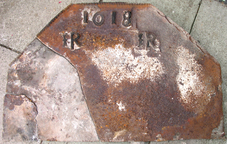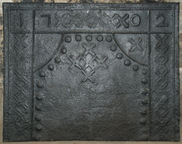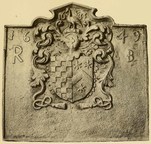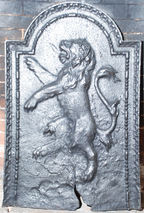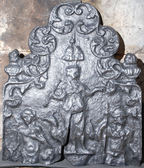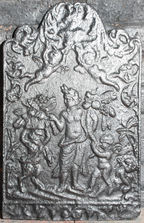-
811
Description: Canted rectangle; twisted rope edging (top and canting only); centre top, date (written as 1018); below to left and right, initials.
Notes: It has been suggested that the initials IR relate to King James I but the lack of any other royal decoration makes this unlikely.
Inscription: 1618 / IR IR
- Decoration tags:
- rectangular with canted top corners (shape)
- rope (edging)
- individual letters
- individual numbers
- text
Manufactured: in 1618 possibly in the Shropshire area of England.
Current location: 50, Church Street, Broseley, Shropshire, England.
- Attached to series:
- Date & initials firebacks
-
1198
Description: Arched rectangular central panel with beaded edging, containing an image of a semi-naked adult male with feathered headdress and 'grass' skirt and holding a club in his left hand; beside hima an adult female also wearing a 'grass' skirt and with a bird perched on her left hand, while holding with her right hand a standing child; within an arched rectangular border with fillet edging, descending from draped foliage on each side, swags or what appear to be coconuts or gourds, and at the bottom a cartouche between swirled foliage; on top, the mask of a putto with dolphins descending on each side.
Notes: One of a series portraying allegories of the four known continents - Europe, Asia, Africa and America; each comprises a pair of adults and a child dressed stereotypically, in this case representative of America. The images were derived from other media, such as paintings or engravings. A copy.
Copies of this fireback are known.
- Decoration tags:
- 'Dutch' (shape)
- fillet (edging)
- whole carved pattern
- pictorial
- allegorical
- animals
Manufactured: in the mid- to late-17th century in the Siegerland area of Germany.
Current location: not known.
Citation: Elling, W. & Winkler-Borck, S., 1992, Ofen- und Kaminplatten (Vreden, Hamaland-Museum).
- Attached to series:
- 'Dutch' Continents firebacks
-
1300
Description: Rectangular shape; twisted rope edging; top centre, a lion passant on the right and a lion passant guardant sinister on the left; in each top corner, a four-petalled Tudor rose; below each rose, two 'imps', one with right arm raised, the other with both arms lowered, the pair on the left facing to the right and the pair on the right facing to the left; below each lion, a crowned, four-petalled Tudor rose.
Notes: A spurious fireback based on, and possibly adapted from, a 16th century back, this and its copies include remodelled rope edging, lions and 'imp' figures, all probably dating from the restoration of Bunratty Castle in the 1960s.
Copies of this fireback are known.
- Decoration tags:
- rectangular (shape)
- rope (edging)
- carved stamps
- heraldic
- animals
- humans
- plants
Manufactured: in the mid-20th century in Ireland.
Current location: Bunratty Castle, Bunratty, County Clare, Republic of Ireland.
- Attached to series:
- Royal series
-
1022
Description: Rectangular, with double fillet edging (top and sides); fillets parallel to top and to each side, dividing the plate into two square corner panels and narrow rectangular panels along top and down each side; fillet arc across inside top corners; date split between top corners, divided by vertical fillets, and separated by a hollow saltire stamp repeated six times; one hollow saltire, with a central bead, between each corner arc; eight similar saltire stamps down each side panel; 27 'daisy heads' arranged regularly around outer edge of central panel, with five saltires arranged in a cross shape in the centre.
Notes: The arc shape and use of repeated 'daisy heads' suggests a common source with other firebacks of the same period; the poor definition is due to insufficient impression at the moulding stage.
Inscription: 17 02
- Decoration tags:
- rectangular (shape)
- fillet (edging)
- carved stamps
- individual numbers
Manufactured: in 1702 in the Forest of Dean area of England.
Current location: Tolsey Museum, 126 High Street, Burford, Oxfordshire, England.
(part of the Tolsey Museum, Burford museum group)
- Attached to series:
- Hollow saltire series
- Newent area group
-
831
Description: Rectangular with small detached pediment; cavetto-moulded edging; upper centre, shield, helm, crest and mantling, with date, 1635, split either side of crest; top, date, 1649, split either side of armorial; initials split either side of armorial, below date.
Notes: The armorial, tentatively associated with the family of Brooke or Broke of Madeley, Shropshire (blazon: chequy argent and sable, impaling a chevron between three estoiles), dated 1635, was formed from a pattern designed for a smaller fireback (see no. 917), but positioned on a larger backing board with the later date and initials added separately, most of the frame of the original fireback being pared away. From an illustration in the catalogue of an exhibition on heraldry at Burlington House, London, in 1894.
Inscription: 16 35 / 16 49 / R B
Arms: poss. Brooke or Broke of Staffordshire
- Decoration tags:
- rectangular with detached pediment (shape)
- cavetto (edging)
- carved stamps
- carved pattern panels
- composite
- individual letters
- individual numbers
- armorial
- text
Manufactured: in 1649 in England.
Current location: not known.
- Attached to series:
- Personal armorial firebacks
- Composite firebacks
-
202
Description: Rectangular; edging formed from furniture moulding; shield of Ayloffe impaling Sulyard impressed weakly seven times (2-3-2), with the same shield impressed eight times (3-2-3), more deeply, in the spaces between the first shields.
Notes: William Ayloffe (c1535-1584) of Bretons, Hornchurch, Essex, Justice of the Court of Queen’s Bench, married (c1560) Jane, dau. of Sir Eustace Sulyard, of Runwell, Essex. A large number of variants use the same shields. Several copies are known of this fireback, but in precisely the same arrangement, all poorly cast, unlike the variants without the additional shields, which are found in many different arrangements, some with dates and initials. From an illustration in the catalogue of an exhibition on heraldry at Burlington House, London, in 1894, it then being at Manor Farm, Edenbridge, Kent.
Copies of this fireback are known.
Arms: Ayloffe impaling Sulyard (William Ayloffe of Bretons, Hornchurch)
- Decoration tags:
- rectangular (shape)
- complex, furniture-derived (edging)
- carved stamps
- heraldic
- armorial
Manufactured: in the early-17th century in the Weald area of England.
Current location: not known.
- Attached to series:
- Ayloffe series
- Personal armorial firebacks
-
21
Description: Rectangular central panel with bead edging all round, pictorial representation of the Annunciation by the Angel Gabriel to the Virgin Mary, the angel carries a lily, Mary kneels at a desk, between them is a basket, above them a dove descends from clouds amid sunbeams, to the left is an arch, in the centre a bed, and to the right a window and a canopy; above the panel is a bead-edged arch with a central scallop shell and a floral swag suspended from scrolls; arched rectangular shaped border with fillet edging, a cascade of leaves and fruit (inc. apples, grapes, pears and pomegranates) descending from a wreath, at the base two cartouches conjoined by a scallop shell and containing the inscription; on top a scallop shell between two dolphins.
Notes: A common fireback design originating in the Siegerland of north Germany and made for the Dutch market. A good clear casting. The illustration is copied from Virgil Solis, 'Biblische Figuren',1562.
Copies of this fireback are known.
Inscription: ANNO 1667
Manufactured: in 1667 in the Siegerland area of Germany.
Current location: Bateman's, Burwash, East Sussex, England.
Museum number: 761056 (part of the National Trust museum group)
Citation: Herskamp, W, 2007, Die Eiserne Bibel (Helios, Aachen).
- Attached to series:
- 'Dutch' Miscellaneous Firebacks
- New Testament firebacks
-
24
Description: Arched rectangular shaped with fillet and cavetto dentil moulding, and paternost bead edging inside; a lion rampant
Notes: Whole pattern. An unusually tall fireback in relation to its width.
Copies of this fireback are known.
- Decoration tags:
- rectangular with round arch (shape)
- cavetto dentil (edging)
- whole carved pattern
- heraldic
- animals
Manufactured: in the 18th century in England.
Current location: Bateman's, Burwash, East Sussex, England.
Museum number: 761107 (part of the National Trust museum group)
- Attached to series:
- Miscellaneous pattern firebacks
-
25
Description: Quasi-arched rectangular shape with arch decorated with floral swirls and an urn on each shoulder; three female figures: Aphrodite on the left, Hera in the centre on a plinth with two peacocks behind her, and Athena on the right; a double tassel hangs above Hera’s head.
Notes: The figures are the participants in the Judgement of Paris, the outcome of which precipitated the Trojan War.
Copies of this fireback are known.
- Decoration tags:
- rectangular with ornate arch (shape)
- fillet (edging)
- whole carved pattern
- pictorial
- mythological
- humans
Manufactured: in the early-18th century in England.
Current location: Bateman's, Burwash, East Sussex, England.
Museum number: 761070 (part of the National Trust museum group)
- Attached to series:
- Late pictorial series (all)
- Late pictorial series 4
-
26
Description: Quasi-arched rectangular shape with swirled and draped foliage across the top; fillet edging with bottom panel containing indistinct floral scrolls; figure of Plenty/Abundance holding a bunch of fruit, accompanied on her left by a cherub, and receiving a further bunch of fruit from a faun to her right; two cherubs hold foliage aloft.
Notes: The figure of Plenty is one of the representations in the Iconologia, published in the early 17th century by Cesare Ripa, and subsequently in other editions. They frequently form the subject of firebacks.
Copies of this fireback are known.
- Decoration tags:
- rectangular with round arch (shape)
- fillet (edging)
- whole carved pattern
- pictorial
- allegorical
- humans
Manufactured: in the early-18th century in England.
Current location: Bateman's, Burwash, East Sussex, England.
Museum number: 761087 (part of the National Trust museum group)
- Attached to series:
- Late pictorial series (all)
